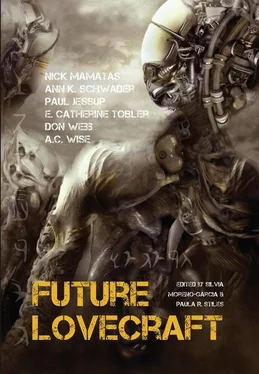Or they had been, before McCabe tried to make himself sleep forever.
✻ ✻ ✻
The walls of the Labyrinth are always black. Basalt, or something that can pass for it; the dreamland equivalent. They always rise up too high to scale, too high to jump. Once you’re in the Labyrinth, you’re in it, submerged, blind to anything except the next corner, and then the next.
Countless efforts have been made to map it. Kendrick has never known a professional who didn’t have at least one in-progress map tacked up somewhere. But no one has ever managed. You can’t see the Labyrinth from anywhere except the top of the hill, near the wall, and from there, it all looks the same and once you’re in it, well….
There are landmarks. Some have been seen by more than one person. He and McCabe had compared their lists late one night. They’d both seen the fountain choked with moss. They’d both seen the doorway in the middle of the courtyard, the ground on the other side of it darker than on this side, but neither of them had been brave or stupid enough to step through. Kendrick had once seen a river, miles down, that cut a roaring chasm through the midst of the Labyrinth. McCabe claimed to have found a building that looked like an abandoned mosque, with no one inside, but an altar set in the back, with some kind of mummy in an alcove behind it, one he couldn’t quite make out without getting closer than he suddenly found himself wanting to.
Some people say that the Labyrinth changes and, certainly, Kendrick has never known two pros whose maps ever really lined up. Most people have an opinion on the subject, once they’ve put a few beers in themselves at the end of the day, but Kendrick never really thought about it before. To him, the Labyrinth was what it was. It was always there, on the other side of the wall, and it was always the same, really. Even if the paths changed, its nature never did and that was enough for him.
✻ ✻ ✻
He stands at one of the gates to the Labyrinth. All the gates he’s ever seen looked identical. No horn or ivory, just unadorned clefts in the sides of the Labyrinth. Others have tried to mark them, he knows, but the markings were always gone when they came back. Either that, or no one has ever gone to the same gate twice.
It should be impossible, what he’s doing. Going into a place that can’t be mapped to find someone who’s been lost there, already. It should be, but it never is. Something’s different about the dreamers, maybe, or about the pros. Something in how they approach the Labyrinth, or in how it approaches them, but he’s never gone in after a dreamer, never once, and not found them.
It isn’t by any conscious art that he does it, though, at the same time, he knows it’s not something everyone can do. He walks the Labyrinth as blind as if he were a dreamer, himself. No one really knows how the professionals do it, the dreamhounds, the oneiroi , as some in the industry have tried to dub them, though the name never stuck. Kendrick has this theories; all the pros do. To him, it’s all in the thinking. Dreamers don’t think while they’re in the Labyrinth, not really. They can’t. They’re caught up in the black, forgetful rivers of sleep. But the riders, those who follow them in, can think and, by thinking, by keeping their minds on their quarry, they can track them down, whether that’s by changing the turnings of the Labyrinth itself, or simply by knowing which way to turn their own steps, Kendrick doesn’t know and has never bothered to care.
Though time has no meaning here, still he knows that this is the longest he’s ever been under. Out of the corners of his eyes, he sees what might be landmarks down curving paths, but already, his feet are carrying him in another direction. He wonders how much time has passed out there in the waking world. It could be hours, minutes, days. They were prepared before he went under. IVs to feed and hydrate him, so that he could stay down, no matter how long it took.
How long will they let him stay? How long before they pull the plug, before they decide that this errand is costing more than it’s worth? He wills himself to hurry.
There are things that live in the Labyrinth. He’s always known it. Not the giants nor the dog-headed men nor any of the other things that live outside. These are different, he knows, even though he’s never seen them. He hears them, sometimes, their hopping, shuffling gait just on the other side of a wall, just a few turns away. Sometimes, in the waking world, he tries to picture them, to imagine them as he goes about his day. He always sees them as pale, eyeless things, adapted to a life lived deep underground, though, of course, the Labyrinth is always open to the perpetual twilight of the dreamlands’ sky.
When he’s here, in the Labyrinth, he tries not to think of them at all, because he believes that thinking here has power. Even now, as he hears them behind him, he tries to think only of putting the next foot in front of him, then the next. Of going faster, not of why. Even when they sound like they are right behind him, just around the next turn, not even that far. That if he turned his head, he would see them, see them at last as they are and not as he imagines. Even then, he keeps his eyes forward, keeps his thoughts only on McCabe, McCabe, McCabe.
And then he turns a corner and he’s somewhere he’s never been before. Normally, in the Labyrinth, he can’t say that, not with certainty. Most of it looks the same, excepting the occasional landmarks. But this is something else entirely. More than a landmark. This is the landmark. He knows it without even having to look around, knows even before his mind has processed what he’s seen, knows with the faultless logic that is sometimes the province of the dreamlands, that this is the center of the Labyrinth.
The things behind him are forgotten and, as if they are driven back by some invisible barrier, or as if it really has been his attention, however indirect, that held them here, the sounds of their pursuit cease. Or was it ever really pursuit? Were they herding him here?
What would he call the structure that he sees before him, this extruded building of green stone, with its soaring towers and many gaping windows, if he saw it in the waking world? A castle, a tower, a house?
There have been countless attempts to map the Labyrinth and even more to explain it. Is it the first step of an afterlife, a tiny taste of death that we get each night when we close our eyes? Is it a representation of something from the collective unconscious, an enormous symbol housed in all our psyches? Is it literally just the maze of our own neurons? These were things Kendrick never thought about, not outside the Labyrinth and certainly not within it, but he thinks about them now.
What does it mean, this structure? No map of the Labyrinth has ever found its center. No rider, no dream hound has ever come this far and returned, at least, not that he’s ever heard of. In the mind of every sleeping man and woman, a maze, and in the centre of the maze, this place. And inside this building, he knows with that same faultless logic, McCabe.
Without hesitating any further, he goes through the front door.
✻ ✻ ✻
Inside, the house is like a castle, though strangely sparse and unfurnished. There are no guttering torches in sconces on the wall, but it isn’t dark, either. The green stone seems to provide its own illumination.
When he passes windows and looks outside, what he sees isn’t the Labyrinth and that doesn’t surprise him. Out one window, massive storm clouds gather into an anvil-shaped thunderhead, crackling with multihued lightning. Out another, he looks down upon a misty valley, where golden statues nestled in peaks watch some kind of gladiatorial game on the distant floor below.
Читать дальше












